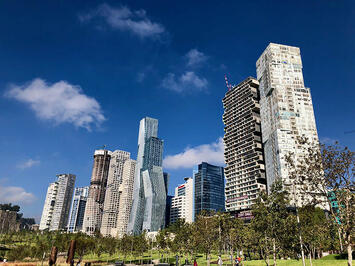
The Mexico City metropolitan area (Zona Metropolitana del Valle de México) continues to grow, though has slowed somewhat from the previous decade. The metropolitan area is the functional or economic city.
The 2020 census of Mexico indicates that the metropolitan area had a population of 21.8 million. This growth was sufficient for Mexico City to remain the largest metropolitan area in North America, above New York’s 2020 census population of 21.4 million. However, the zona metropolitan has fewer residents than 23.6 million in the New York combined statistical area (a larger metropolitan definition).
The metropolitan population was up 8.4% from the 2010 Census but this represents a drop from 9.3% from 2000 to 2010, not to mention 18.2% growth between 1990 to 2000 growth (Figure 1).
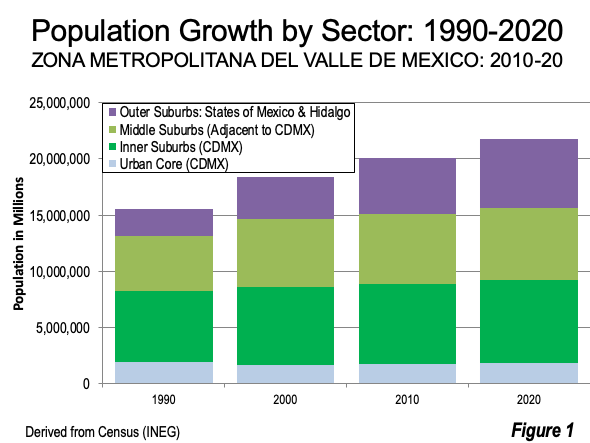
Nor is Mexico City still a leader in the country’s growth. Over the last decade the annual growth rate of 0.81% was 30% below the 1.16% for the nation as a whole. The slow growth marks a considerable contrast with the 1980 United Nations (UN) projection that Mexico City would become the largest urban agglomeration in the world by 2000, amassing a 5.2 million lead over projected second ranked Sao Paulo and 7.6 million above third ranked Tokyo (Figure 2). However, what the UN could not predict was the devastating 1985 Mexico City earthquake, after which population growth dropped substantially.
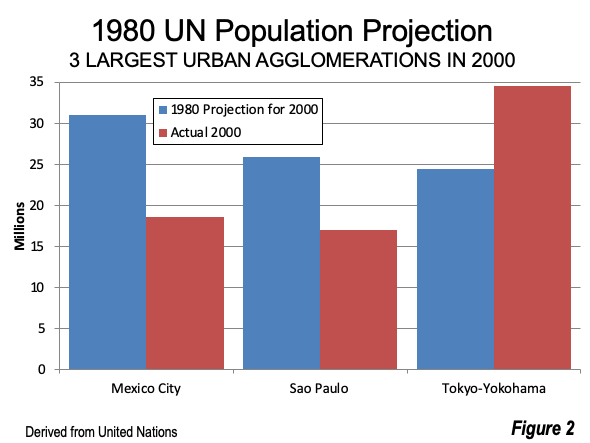
The Mexico City metropolitan area is located in three state level jurisdictions, Ciudad de Mexico (CDMX, or Mexico City) and the states of Mexico and Hidalgo. CDMX replaced the former Distrito Federal in 2016, but, as the national capital, could not become a state under the Constitution of Mexico.
Suburban Growth Dominates
In the last decade, 93% of the growth in the Zona Metropolitana was in the suburbs, and 7% was in the urban core (Figure 3).
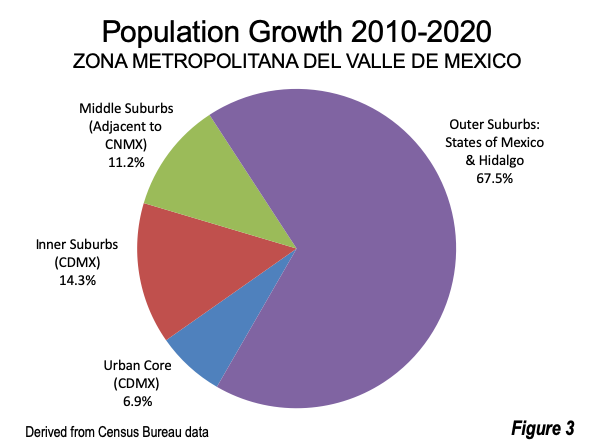
Ciudad de Mexico (city of Mexico City, CDMX): The Ciudad de Mexico includes the historic urban core and the area to the outside, or the inner suburbs (below).
Urban Core (CDMX): The urban core, made up of the delegations (wards) of Benito Juárez, Cuauhtémoc, Miguel Hidalgo and Venustiano Carranza added nearly 120,000 residents, or 7% of the growth. The annual growth rate was 0.66%, nearly 45% below the national rate.
Typical of many world metropolitan areas, urban core populations have fallen. These delegations combined for a population of 2.2 million in 1950, peaked at 2.9 million in 1970 and now have more than a third fewer residents (1.8 million). The population loss bottomed out in recent decades, reaching a low of 1.7 million in 1990, about 40% below the 1970 peak (Figure 4). The population density peaked in 1970 at 20,500 per square kilometer (53,900 per square mile), and was down to 13,200 per square kilometer (34,100 per square mile) in 2020. Zocolo, the historic core of Mexico City is located in Cuauhtémoc. The newer commercial core, Reforma, is located in Miguel Hidalgo.
Inner Suburbs (CDMX): The suburbs outside the urban core, but within CDMX added nearly 250,000 residents, or 14% of the growth. The 0.33% annual population growth rate was more than 70% below the national rate. The strongest growth in the inner suburbs was in municipios (municipalities) on the urban fringe, where CDMX backs up on mountainous terrain. Cuajimalpa de Morelos (2020 population 218,000, grew 16.8%, while Milpa Alta (153,000 grew 16.9%).
The newer suburban commercial centre, Santa Fe, is located in Álvaro Obregón, along the freeway to Toluca, the capital of the state of Mexico (approximately 50 kilometers/30 miles to the west). Appealing to many foreign businesses, the area looks more like LA’s Century City to what one would expect in the capital of a developing country.
Suburbs Outside CDMX: The suburbs outside CDMX are divided in this analysis between the Middle Suburbs and the Outer Suburbs.
Middle Suburbs: The middle suburbs, located in the state of Mexico and adjacent to CDMX added about 200,000 residents, or 11% of the growth. The middle suburbs accounted for the least percentage of population growth from 2010 to 2020. The annual population growth rate was 0.30%, nearly three quarters lower than the national rate of 1.16%.
The three largest municipios (municipalities) had virtual stability in their population over the decade. The largest, Ecatepec de Morelos (1.65 million in 2020) lost 0.6% of its population. Nezahualcóyotl (1.08 million) lost 3.0%, while Naucalpan de Juárez (0.83 million) lost 0.1%.
Outer Suburbs and Exurbs: Between the two censuses, the outer suburbs and exurbs, located in the states of Mexico and Hidalgo, grew by 1.1 million and captured 68% of the population growth. Municipios on or near the urban fringe (edge of the continuously developed urban area) have grown the most. Tecámac (547,000 in 2000) grew 50.2% and Zumpango (281,000 grew 75.7%. Huehuetoca (163,000, up 63.2%) and Tizayuca (168,000, up 72.7%). Tizayuca is in the state of Hidalgo, while the other three are in the state of Mexico.
The highest percentage population increase during the decade was in the Outer Suburbs, with an annual growth rate of 2.06%. This is almost 80% above the national rate and the only sector of the metropolitan area that grew faster than the nation as a whole (Figure 4).
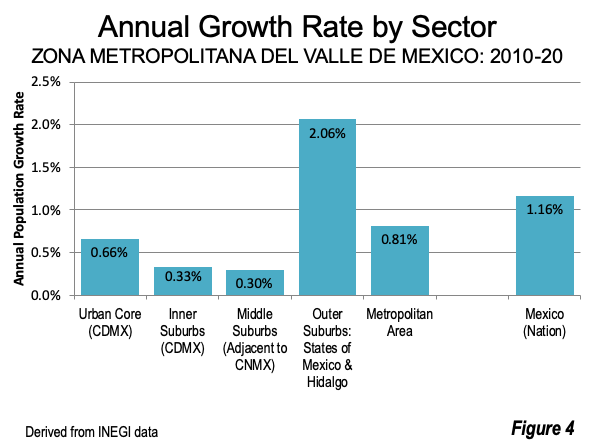
Fitting the International Metropolitan Growth Pattern
As with nearly all metropolitan areas in the world, most growth in Mexico City has been in the suburban and exurban areas in recent decades, as opposed to the urban core. The urban core has lost population from its peak, as in other metropolitan areas like Paris, inner London, Lisbon, Vienna, and Boston. Like Paris inner London, Vienna and Boston, some, but not all of the recent population loss of recent loss has been recovered.
Typical of the international experience, Mexico City’s inner and middle suburbs have tended to grow more slowly than the suburbs on the urban fringe (continuously built up area) and the exurbs (beyond the continuously built up area). Although there has been a modest resurgence of population growth in the urban core, as in other major international cities, the preponderant growth has taken place on the urban periphery, where the cost of land is generally more affordable.
Related Articles
Expanding, Productive Mexico City Urban Form
The Evolving Urban Form: Suburbanizing Mexico
The Evolving Urban Form: The Valley of Mexico
Wendell Cox is principal of Demographia, an international public policy firm located in the St. Louis metropolitan area. He is a founding senior fellow at the Urban Reform Institute, Houston, a Senior Fellow with the Frontier Centre for Public Policy in Winnipeg and a member of the Advisory Board of the Center for Demographics and Policy at Chapman University in Orange, California. He has served as a visiting professor at the Conservatoire National des Arts et Metiers in Paris. His principal interests are economics, poverty alleviation, demographics, urban policy and transport. He is co-author of the annual Demographia International Housing Affordability Survey and author of Demographia World Urban Areas.
Mayor Tom Bradley appointed him to three terms on the Los Angeles County Transportation Commission (1977-1985) and Speaker of the House Newt Gingrich appointed him to the Amtrak Reform Council, to complete the unexpired term of New Jersey Governor Christine Todd Whitman (1999-2002). He is author of War on the Dream: How Anti-Sprawl Policy Threatens the Quality of Life and Toward More Prosperous Cities: A Framing Essay on Urban Areas, Transport, Planning and the Dimensions of Sustainability.
Photo: Santa Fe business center in the western suburbs, via Wikimedia under CC 4.0 License.












